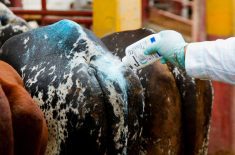U.S. livestock futures fell Tuesday as investors were reluctant to trade after the U.S. government shut down many reporting agencies, due to a lack of funding and a congressional logjam over several other issues including immigration reform, the federal debt and a new farm bill.
Agencies viewed as essential will remain open such as the federal meat inspection service, to ensure a safe food supply.
The partial shutdown of the government began to delay the release of data which left policymakers and investors in a fog.
Read Also

Prairie Wheat Weekly: Prices up in most areas
Cash prices for spring wheat and durum across the Canadian Prairies were mostly higher during the week ended Nov. 4. As Minneapolis spring wheat stepped back, there was a modest increase in Kansas City hard red while Chicago soft red was up sharply.
CME Group said a prolonged shutdown could affect settlement prices for cash-settled dairy, lean hogs, live cattle and feeder cattle contracts.
“It is a big mess and I think that is a big reason we’re lower, at least on cattle. People won’t want to trade while this is going on,” said Dennis Smith, a livestock broker for Archer Financial.
“It makes my private contacts with Urner Barry more important, I will have to rely on them almost solely for market information now,” Smith said.
Urner Barry is a business publisher specializing in reporting market news and quotations from the poultry, egg, meat, seafood and related segments of the food industry.
Live cattle futures closed lower despite higher cash cattle markets late last week. And futures eased despite a firm wholesale cash beef market late on Monday, the last such report that was issued before the government shuttered the doors of the U.S. Department of Agriculture (USDA) agency responsible for reporting beef market trends.
“The whole government shutdown thing has the market nervous and that is eliminating risk-taking. Anytime you have this kind of uncertainty, no one is willing to take a risk,” said Sterling Smith, futures specialist for Citigroup.
Chicago Mercantile Exchange (CME) October live cattle futures closed down 0.6 cents per pound at 127.25 cents and December was down 0.075 at 131.9.
Feeder cattle futures bucked the trend and ended firm on bargain buying as Chicago Board of Trade corn futures fell to a three-year low. The falling corn prices and related drop in feed costs led to increased demand for young cattle to place in the nation’s vast network of feedlots.
CME October feeder cattle were up 0.3 cent/lb. at 164.4 cents, and November ended up 0.85 at 166.05.
Traders and analysts said hog futures had started to falter even before the government shutdown but the lack of available information to trade likely led to further pressure on the hog futures market.
“Hogs also are down due to the government shutdown but also based on the USDA saying there are more hogs out there than anyone expected,” Smith said.
Friday’s U.S. Department of Agriculture report showed the U.S. hog herd unexpectedly held steady from the June-August quarter versus a year earlier despite the spread of the porcine epidemic diarrhea virus (PEDv), which is fatal to baby pigs.
“There will be more hogs coming to market in October and November than anyone thought,” Smith said.
CME October lean hogs were down 1.05 cents/lb. at 90.925 and December was down 0.725 at 85.9.
Cash hogs traded steady to $1 per hundredweight lower across the U.S. Midwest, dealers said.
— Sam Nelson is a Reuters correspondent covering agricultural futures markets from Chicago.














